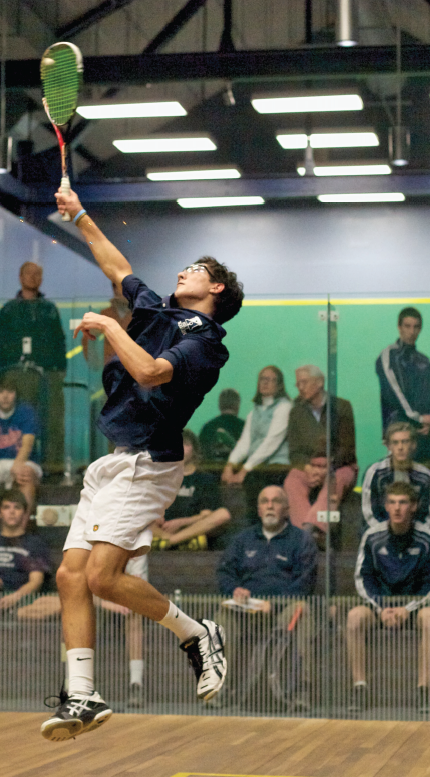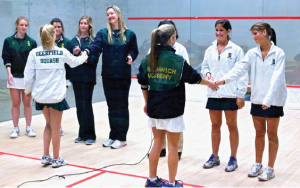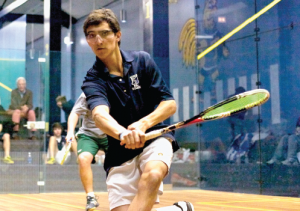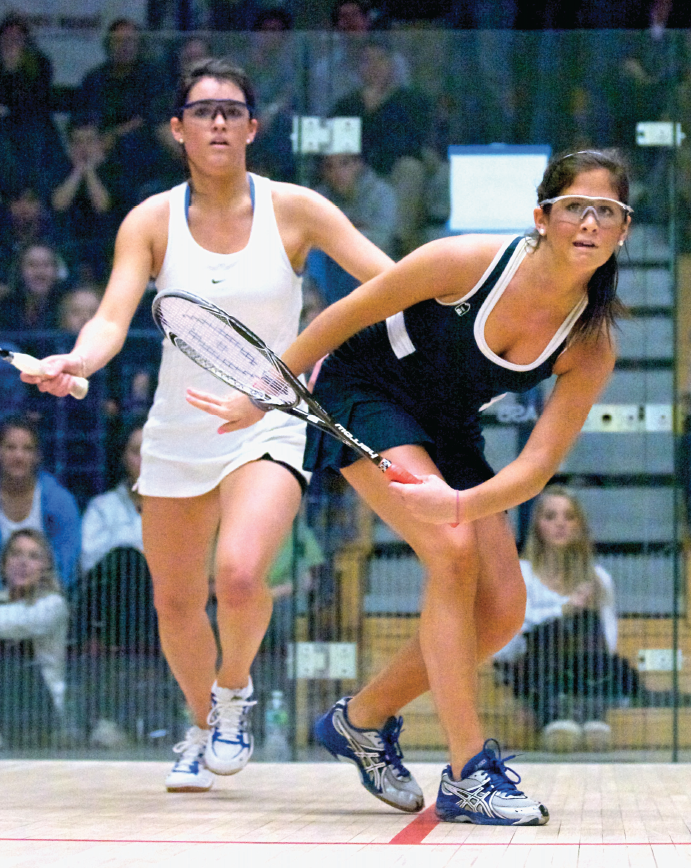By James Zug
Photos by Seth Packard

The largest squash tournament in the world is a superlative that is hard to confirm but the facts seem to support the 2011 U.S. High School Team Squash Championships: seven kids a team and 141 teams equals 987 players. Add in the fact that many teams brought an extra player or two (most high school dual matches are now nine players rather than the traditional seven) and you’ve got over a thousand kids at the weekend.
That’s a big number. The British Junior Open this year had 408 players (from 40 nations). The only amateur tennis tournament that is bigger is the USTA’s League Southern Section Championships in Alabama which regularly tops two thousand.
Episcopal Academy won the boys title, beating Berkshire 6-1 and then Gilman, Belmont and Taft all by the close-but-not-too-close score of 5-2. Led by Andrew McGuinness at No.1 and coached by Joe Russell, with help from Brian Callahan, Tina Rix and Alan Dupree, the Churchmen captured their third straight title.
Going them one better were the girls of Greenwich Academy. They won their fourth straight title (and sixth out of seven). Under new coach Suzie Pierrepont, they narrowly survived a mid-season dual match against Deerfield, 4-3, but at the nationals the Gators grabbed the victory 6-1.
With ten divisions (six for boys, four for girls), it was a wildly variegated tournament. Hopkins School had a pint-sized seventh grader on their squad, Spencer Lovejoy, perhaps the youngest player at the nationals. A raft of public schools came, as did dozens of teams that had no courts but managed to scrabble together court-time at local clubs. There were co-ed teams and teams from a dozen states including Missouri and South Carolina.

I was the assistant coach for the St. Andrew’s School boys and girls and we had an exciting weekend. Both teams had very close 4-3 victories and losses, and we found some unlikely heroes. After losing twice to Episcopal High School in the regular season, the SAS boys managed to eek out a hard-fought 4-3 win, with sophomore Z Roach clinching the key match.
Because it was so large, the tournament sprawls around central Connecticut. Four squash centers burst at the seams: Yale, Wesleyan, Trinity and Choate Rosemary Hall and it was fitting that matches went to Choate since the origins of the tournament were there.
Squash has always been a schoolboy game in the U.S. The first courts were built at St. Paul’s School in 1884. By 1930 leagues had begun, and in the mid-1950s boys’ boarding schools organized the New England Interscholastic Squash Association. (Today NEISA has 39 schools; it ran its 58th annual championships two weeks after the high school championships.) Girls squash didn’t really take off until the 1970s.
Players had no way of backing up boasts, often voiced at junior tournaments, about which school had a better team. In the 1970s when Episcopal was dominant and in the 1980s when Haverford (in one stretch the Fords went more than a decade without losing to a high school and even beat some top colleges), they would claim to be national champions.
But no one ever knew for sure as never did the two main high school proving grounds at the time, the Inter-Ac and NEISA, cross paths. The one exception was the Choate Invitational, a team schoolboy tournament held in January and begun in 1978 and ended a decade later. The Choate Invitational had only a few teams and each could only field five players, so it wasn’t much of a national proving ground, but it was all there was and in it were the seeds of the High School Championships.
In 2003 Melinda Justi asked Ned Gallagher, the executive director of NEISA, if Haverford, her son Parker’s team, could enter his tournament. “Parker’s friend Bucky Marshall played for Groton,” Justi said, “and I would hear about how the Interscholastics were so much fun.” Gallagher reluctantly said it was limited to schools in the New England School Athletic Council (most of which are boarding schools). She asked the USSRA if they could do a nationals, and they said no too. Boarding schools had rules about missing classes and long weekends away and the USSRA didn’t have the band-width at the time to take on another national championship, especially a new one.

Justi was undeterred. “I felt there was no good reason why the Philadelphia-area teams could not have an event where they and the New England teams and, for that matter, any high school team could compete,” she said. “This would open up a whole new opportunity for players to meet other players of varying abilities from all over instead of playing the same people over and over again. It would also enable the players to get a feel for how great team squash can be and how college squash is with lots of cheering and team unity.”
So she did it herself. She asked Groton if they would host the weekend (thinking it would be more attractive to the boarding schools if it was close to them) and sent out the word. Fourteen boys teams came, braving a massive snow-storm (one team came from Chicago). Bucky’s mother Laurie and Justi went to Costco and loaded a car full of food to serve lunch each day. The finals, between Brunswick and Lawrenceville, came down to a 3-3 dual match score and the final match went to a fifth game.
In 2005 it was at Yale with 21 boys teams. On the suggestion of Bryan Patterson, Justi started a girls’ division and 11 girls teams came. Eventually, U.S. Squash took over the management of the tournament. In 2008 they started a middle school championships. The division one trophies are named after Justi (boys) and Patterson (girls).
And that is how 86 boys and 55 girls teams spent a weekend playing four dual matches and laughing and crying and trying to be the best squash players they could.

Division Championship Results
Boys:
DI: Episcopal Academy (PA) def. 5-2 Taft (CT)
DII: Collegiate School (NY) def. 4-3 Milton Academy (MA)
DIII: St. Lukes (CT) def. 5-2 Boy’s Latin (MD)
DIV: Deerfield Academy def. 5-2 St. Andrew’s (DE)
DV: Delbarton School def. 4-3 St. George’s School (RI)
DVI: The Park School (MD) def. 4-3 Radnor (PA)
Girls:
DI: Greenwich Academy (CT) def. 6-1 Deerfield Academy (MA)
DII: Springside School (PA) def. 4-3 Greenwich Academy B (CT)
DIII: Winsor School (MA) def. 4-3 Potomac School (VA)
DIV: Anges Irwin (PA) def. 6-1 Greens Farms Academy (CT)





